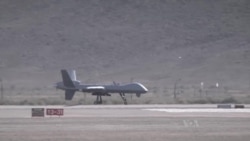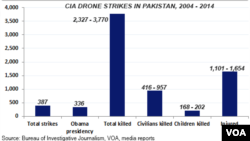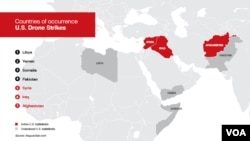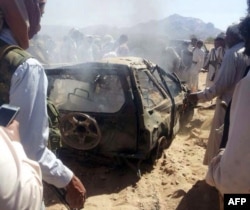The White House has released a long-anticipated report on civilians killed in drone strikes outside active conflict zones, saying between 64 to 116 civilians have been killed between 2009 and 2015.
White House Spokesman Josh Earnest said the administration's counterterrorism strategy has more credibility when it is transparent as possible, and the president is announcing a new executive order aimed at providing additional information on efforts to avoid civilian casualties and to catalog and disclose those that do occur.
“We are now in a position where we are describing the process for making decisions about these kinds of operations and being rather transparent with not just the American public, but with the world about the outcomes of those operations, even when the outcome is not entirely consistent with our intentions,” he said.
The report covers drone strike deaths that occur in places outside what the administration calls "areas of active hostilities." That includes strikes in Pakistan, Yemen, Libya and Somalia, but not ones in Afghanistan, Iraq or Syria.
The official total is lower than the estimates of outside groups, which have ranged from around 200 to more than 1,000.
The report says that the government's lower tally is because it relies on sensitive intelligence and uses methodologies that are unavailable to outside groups, which generally rely on a mix of media reports and some field research.
It says the differing methodologies mean that some deaths which are counted as non-combatants by outside groups are considered combatant deaths by the U.S. government. It also says that reporting by outside groups may be complicated by the deliberate spread of misinformation by some actors, which may be inadvertently included in local media reports.
The rights group Human Rights Watch criticized the report, saying the United States has failed to explain who it targets and why, making it impossible to corroborate its casualty figures.
"Unless details are provided on specific incidents, it's not possible to determine if individuals killed were civilians, and thus whether the U.S. is complying with its own policy and with international law," said Laura Pitter, senior U.S. national security counsel at Human Rights Watch.
A British-based organization that tracks drone strikes via local media reports, the Bureau of Investigative Journalism, welcomed the report as "a step towards greater transparency." But in a statement sent to VOA, the group disputed the number of civilian deaths in what it referred to as President Barack Obama's "controversial" drone program.
"This is a fraction of the 380 to 801 civilian casualty range recorded by the Bureau of Investigative Journalism from reports by local and international journalists, [nongovernmental organization] investigators, leaked government documents, court papers, and the result of field investigations," the group said.
The group also criticized the United States for not giving information on specific drone strikes in its assessments of drone operations, saying the lack of information made it impossible to reconcile its numbers with the U.S. figures.
Full disclosure?
The first U.S. drone strike was carried out in October 2001, narrowly missing former Taliban leader Mullah Omar in Kandahar at the beginning of the U.S.-led offensive in Afghanistan. Since then, the weapon has been widely deployed in conflict zones around the world, as well as in other places targeting top terrorist leaders.
In Pakistan alone, the U.S. has carried out 392 airstrikes since 2008, according to The Long War Journal. In Yemen, U.S. strikes targeting al-Qaida commanders total 145 since 2002.
The figures are based on press reports.
Human rights groups have long called for hard numbers when it comes to counterterrorism strikes that until recently the administration refused to even confirm.
“Saying ‘just trust us, we have high standards, we are doing the best we can’ really isn’t enough and that they need to be disclosing more,” said Rita Siemion of Human Rights First.
While the weapon is widely used in combat zones, its use in areas where the U.S. military is not actively involved in fighting has been more controversial. In March this year, the administration announced it would release a report to try to improve transparency on those strikes.
"For a decent portion of this administration and the previous one, we wouldn’t even acknowledge publicly that these things were taking place," Earnest told reporters at the time. "The fact that we’re now in a position on a regular, routinized basis to publish the results and to quantify that totals about the impact of these operations I do think represents substantial progress in the direction of transparency."
Contradictory counterterror policy?
Drones give the military a way to strike at terrorist leaders in places that U.S. forces are unable to access. That has led even some people in areas where they are carried out, such as Mogadish resident Fatuma Ilmi Mus, to support their use.
“There are people who are being targeted, these people [al-Shabab] they are also fighting us and they are in the bush and we are not shielding them. These drones must be manned by a professional so that it does not hit our animals, our people and homes but to hit the intended target and where the enemies are,” she told VOA.
But even when drones do hit their intended target, it can still cause a backlash. In Pakistan, where a strike killed Afghan Taliban leader Mullah Akhtar Mansoor in Pakistan earlier this year, the government expressed outrage because the strike occurred outside of Pakistan's lawless border area with Afghanistan.
“The U.S. provides so much funding to Pakistan though USAID and development funds. But then it does something [like the strike against Mansoor] that scuttles all that effort,” Islamabad resident Hina Ahmed said.
Still others say the administration's use of strikes has undermined intelligence gathering efforts that are key to defeating terror groups.
Foundation for Defense of Democracies’ Senior Counselor John Hannah served as senior adviser in the Clinton administration and the George W. Bush administration.
“The Obama administration has almost completely foregone an effort to capture and detain and get intelligence from these terrorists,” he said. “Instead it has universally decided it’s going to be the judge, jury and executioner and take the lives of these terrorists, as well as the lives, unfortunately, of a lot of innocent people.”
Still, Hannah says drone strikes are an effective tactic in countries like Yemen and Pakistan, where the government is either unwilling or unable to go after terrorists — while minimizing civilian casualties — compared to conventional military conflict.
The key, Hannah says, is creating the necessary institutions and safeguards to create accountability, while balancing national security, transparency, and rule of law.
“Ensure that we are not crossing that line into becoming a lawless nation,” he said. “It’s very difficult and challenging, and I think it’s a challenge that will continue into the future.”
VOA's Ayesha Tanzeem in Islamabad and Mohammad Yusuf in Mogadishu contributed to this report.













